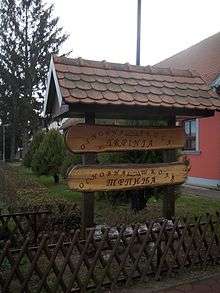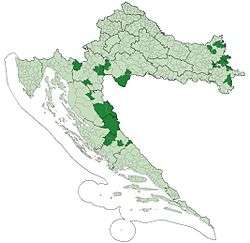Serbian language in Croatia
The Serbian language is one of the officially recognized minority languages in Croatia. It is primarily used by the Serbs of Croatia. The Croatian Constitution, Croatian Constitutional law on national minorities rights, Law on Education in language and script of national minorities and Law on Use of Languages and Scripts of National Minorities define the public co-official usage of Serbian in Croatia. Serbian and Croatian are two standardized varieties of the pluricentric Serbo-Croatian language. Majority of Serbs of Croatia use Ijekavian pronunciation of Proto-Slavic vowel jat except in the Podunavlje region in Vukovar-Srijem and Osijek-Baranja Counties where local Serb population use Ekavian pronunciation. Post-World War II and Croatian War of Independence settlers in Podunavlje which have come from Bosnia, Dalmatia or Western Slavonia either use their original Ijekavian pronunciation, adopted Ekavian pronunciation or both of them depending on context. In 2011 Census majority of Serbs of Croatia declared Croatian standardized variety as their first language with Ijekavian pronunciation always being required standard form in Croatian. While Serbian variety recognizes both pronunciations as standard Ekavian is the more common one as it is the dominant one in Serbia, with Ijekavian being dominant in Bosnia-Herzegovina, Montenegro and Croatia.
History
The Orthodox liturgical book Varaždin Apostol from 1454 represents the oldest preserved text in Cyrillic from the territory of today's Croatia.[1] Croatian Constitutional law on national minorities rights, one of only two constitutional laws in country, entered into force on 23 December 2002.[2]
In April 2015 the United Nations Human Rights Committee urged the Croatian government to ensure the right of minorities to use their language and alphabet.[3] The report noted the use of Serbian Cyrillic in Vukovar and municipalities concerned.[3] Serbian Foreign Minister Ivica Dačić said that his country welcomes the UN Human Rights Committee's report.[4]
Serbian language education

Most schools with instruction in Serbian are located in Vukovar-Srijem and Osijek-Baranja County in the area of former Eastern Slavonia, Baranja and Western Syrmia where rights on education in minority languages were provided during the United Nations Transitional Administration for Eastern Slavonia, Baranja and Western Sirmium based on the Erdut Agreement. Today with those schools there is also Kantakuzina Katarina Branković Serbian Orthodox Secondary School in Zagreb.
In the school year 2010–2011, 3.742 students attended kindergartens, primary and secondary schools in Serbian.[5] 59 educational institutions offered Serbian language education that year and 561 educators and teachers worked in them.[5] In school year 2011–2012 the total number of students was 4.059 in 63 educational institutions and 563 educators and teachers worked in them.[5] Number of classes or groups in this period increased from 322 to 353.[5]
As a chair at the Department of South Slavic languages, Faculty of Humanities and Social Sciences at the University of Zagreb has a The Chair of Serbian and Montenegrin literature.[6] Among the others, lecturers of Serbian literature at the university over the time included Antun Barac, Đuro Šurmin and Armin Pavić.[6]
Other forms of cultural autonomy
Various minority organizations use Serbian in their work. One of them, Association for Serbian language and literature in Croatia from Vukovar is a nonprofit professional organization that brings together scientists and technical workers in the Republic of Croatia engaged in studying and teaching of Serbian language and literature.
The co-official use at local government level
The Law on Use of Languages and Scripts of National Minorities provides for a mandatory co-official use of minority languages in municipalities of Croatia with at least one third of members of ethnic minority. Municipalities Dvor, Gvozd, Jagodnjak, Šodolovci, Borovo, Trpinja, Markušica, Negoslavci, Biskupija, Ervenik, Kistanje, Gračac, Udbina, Vrbovsko, Donji Kukuruzari, Erdut and Vukovar, according to the provisions of law, are obliged to grant equal co-official use of Serbian language and Serbian Cyrillic alphabet. Law enforcement is facing great resistance in the part of the majority population, most notably in the case of Vukovar where it led to 2013 Anti-Cyrillic protests in Croatia.

| Municipality | Name in minority language | Affected settlements | Introduced based on | Population (2011) | Percentage of affected minority (2011) |
County |
|---|---|---|---|---|---|---|
| Vrbovsko | Врбовско | All settlements | Constitutional Act | 5,076 | 35,22% | Primorje-Gorski Kotar |
| Vukovar | Вуковар | All settlements | Constitutional Act | 27,683 | 34,87% | Vukovar-Srijem |
| Biskupija | Бискупија | All settlements | Constitutional Act | 1,699 (2001) | 85,46% | Šibenik-Knin |
| Borovo | Борово | All settlements | Constitutional Act | 5,056 | 89,73% | Vukovar-Srijem |
| Civljane | Цивљане | All settlements | Constitutional Act | 239 | 78,66% | Šibenik-Knin |
| Donji Kukuruzari | Доњи Кукурузари | All settlements | Constitutional Act | 1,634 | 34,82% | Sisak-Moslavina |
| Dvor | Двор | All settlements | Constitutional Act | 6,233 | 71,90% | Sisak-Moslavina |
| Erdut | Ердут | All settlements | Constitutional Act | 7,308 | 54,56% | Osijek-Baranja |
| Ervenik | Ервеник | All settlements | Constitutional Act | 1 105 | 97,19% | Šibenik-Knin |
| Gračac | Грачац | All settlements | Constitutional Act | 4,690 | 45,16% | Zadar |
| Gvozd | Гвозд or Вргинмост | All settlements | Constitutional Act | 2,970 | 66,53% | Sisak-Moslavina |
| Jagodnjak | Јагодњак | All settlements | Constitutional Act | 2,040 | 65,89% | Osijek-Baranja |
| Kistanje | Кистање | All settlements | Constitutional Act | 3,481 | 62,22% | Šibenik-Knin |
| Krnjak | Крњак | All settlements | Constitutional Act | 1,985 | 68,61% | Karlovac |
| Markušica | Маркушица | All settlements | Constitutional Act | 2.576 | 90,10% | Vukovar-Srijem |
| Negoslavci | Негославци | All settlements | Constitutional Act | 1.463 | 96,86% | Vukovar-Srijem |
| Plaški | Плашки | All settlements | Constitutional Act | 2,292 (2001) | 45,55% | Karlovac |
| Šodolovci | Шодоловци | All settlements | Constitutional Act | 1,653 | 82,58% | Osijek-Baranja |
| Trpinja | Трпиња | Village Ćelije excluded in municipality Statute[7] | Constitutional Act | 5,572 | 89,75% | Vukovar-Srijem |
| Udbina | Удбина | All settlements | Constitutional Act | 1,874 | 51,12% | Lika-Senj |
| Vojnić | Војнић | All settlements | Constitutional Act | 4,764 | 44,71% | Karlovac |
| Vrhovine | Врховине | All settlements | Constitutional Act | 1,381 | 80,23% | Lika-Senj |
| Donji Lapac | Доњи Лапац | All settlements | Constitutional Act | 2,113 | 80,64% | Lika-Senj |
| Kneževi Vinogradi | Кнежеви Виногради | Kneževi Vinogradi and Karanac[8] | Municipality Statute | 4,614 | 18.43% | Osijek-Baranja |
| Nijemci | Нијемци | Banovci and Vinkovački Banovci | Municipality Statute | 4,705 | 10,95% | Vukovar-Srijem |
See also
References
- "A823". Biskupija-varazdinska.hr. Retrieved 2012-09-12.
- Serb Democratic Forum. "Provedba Ustavnog zakona o pravima nacionalnih manjina u jedinicama lokalne i područne (regionalne) samouprave" (PDF) (in Serbian). Retrieved 3 May 2014.
- B92 (3 April 2015). "UN calls on Croatia to ensure use of Serbian Cyrillic". Retrieved 2015-04-11.
- Tanjug (3 April 2015). "Serbia welcomes UN stance on use of Cyrillic in Croatia". Archived from the original on 11 April 2015. Retrieved 2015-04-11.
- Government of Croatia (October 2013). "Peto izvješće Republike Hrvatske o primjeni Europske povelje o regionalnim ili manjinskim jezicima" (PDF) (in Croatian). Council of Europe. p. 36. Retrieved 2 December 2016.
- Faculty of Humanities and Social Sciences. "The Chair of Serbian and Montenegrin Literature". University of Zagreb. Retrieved 7 August 2017.
- "Statut Općine Trpinja" (PDF). Retrieved 23 June 2015.
- "Statut Općine Kneževi Vinogradi , article 15" (PDF). Retrieved 20 August 2015.